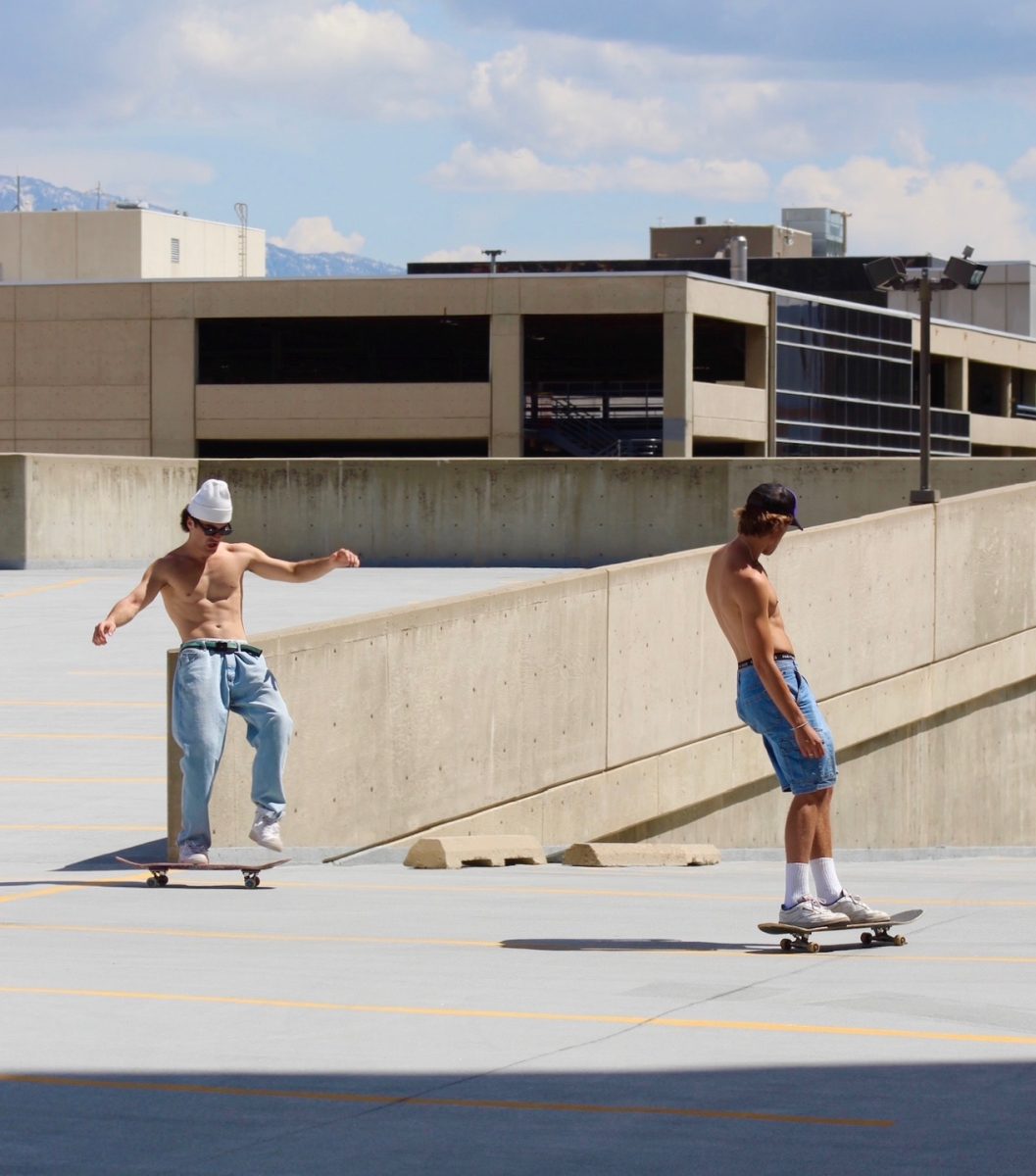Student-Led Commission at BYU Advocated for Accessibility, Created Framework for Other Campuses
North Campus, Brigham Young University (Photo by Jaren Wilkey | CC BY-SA 3.0)
May 1, 2023
Kendra Muller, a civil rights attorney who works at Disability Rights California, the nation’s largest non-profit disability rights firm, graduated from Brigham Young University in 2019 in neuropsychology.
Muller currently assists in providing intersectional legal analysis to advocate for underserved communities. They serve on the San Diego County Bar Association’s disability committee, help disabled individuals pursue legal careers though Disability Rights Now and are now a member of the Nature Collective, which promotes accessible nature for all.
“I am disabled — I’m a disabled person,” Muller said. “I have a spinal cord injury and then I also have mental health issues.”
Throughout her time at BYU, she experienced barriers to getting accommodations and thought she might be the only one experiencing these issues.
“Disability is still a taboo subject, especially in the academic field,” Muller said. “Because academia has been previously hyper-abled people, and that’s the stereotype. So anyone with a disability in an academic, post-secondary education environment, it can be difficult, so I just didn’t really talk about it with people.”
However, after talking with different people and sharing experiences, Muller realized it was a systemic issue, and wanted to center strong action around it.
“We wanted to do something that would be physically present in the minds of individuals because we saw it as a human rights issue,” they said.
As a queer woman with a disability, Muller recognized the importance of approaching this situation with an understanding of intersectional identities. Her civil rights professor helped her see that both a cross-sectional and focused analysis would be helpful.
Solutions They Explored
First, Muller and other students tried t0 work within the framework of the institution to make change. They worked with the University Accessibility Center, for example, to map out buildings on campus. With BYU’s approval, they also made a social media campaign to combat disability stereotypes. However, they felt a lack of support and action from the university itself.
“The university did not deem [these projects] important or necessary,” Muller said. “If working within the university’s framework does not work, which it did not for us, then other solutions can be tried.”
Muller did an undergraduate thesis in international human rights with a focus on truth commissions, which are human rights bodies “set to investigate human rights violations throughout the global human rights field,” she said. This became the methodology for the project.
The commissions not only investigate the violations, but they also “provide transparent documented evidence of violations, give voice to victims of discrimination and impart subsequent recommendations,” Muller explained.
Muller said while not perfect, their group liked the methodology overall. Thus, the Equal Access and Disability Rights Commission was born.
There are two main aspects to a truth commission model, she explained. The first — gathering statements.
“We spent months collecting statements from students that described their experience with the university, and recommendations they had to improve the university,” Muller said. “Statements were difficult to collect as many students were intensely fearful of retaliation, and this was a very valid fear.”
Whether it was written or verbal, “getting them in their own words is really powerful,” Muller said.
The second aspect is statistical and legal methodology. Muller and their group looked at the overall systemic impact of inaccessibility at BYU as a whole. They wanted a combination of student recommendations as well as scientific research behind how to make a universally accessible campus.
A major component of the truth commission model is being fully transparent and providing documentation of processes and results. So, they compiled everything in their 100-page final report.
The Final Report
After all the conversations they had, they knew they had to not only frame the issue as a serious one, but also as a human rights one.
Statements reflected lack of training, ignorance about accessibility accommodations, miscommunication between different departments on campus, exclusion from different aspects of campus, bullying and lack of assistance from the UAC.
The group included solutions in their report, to make it easier on anyone who wanted to make change.
At the time, the accessibility center on campus did not have a voicemail. The group recommended implementing one so that students had another contact point for the office.
“So a lot of the recommendations weren’t like money-based, they weren’t going to be this huge overhaul,” she said. “They were hopefully feasible changes that could have been done.”
One recommendation for administration was to ensure accommodations for students with disabilities, as well as to listen and advocate for its students.
Another recommendation for the UAC was to rethink its Accessibility Week to be more inclusive of individuals with all different types of disabilities, “whether they be physical, temporary, invisible, and mental illnesses.”
“Training is needed for how to properly handle confidential information, such as medical documentation. Many statements of students have shared that the UAC has forgotten about them or lost vital paperwork. The UAC needs to organize its processes to make sure each student is being properly taken care of,” another recommendation read.
After interviewing 479 people with disabilities, they reported 84% said that accessible door buttons are not truly accessible.
Other recommendations included signage for ramp drop-offs, eliminating extra buttons to open doors, making sure accessible pathways are the shortest, not the longest route, ensuring there are multiple accessible seats in classrooms, not the furthest seat from the board and more. Read more recommendations in the final report here.
The Response
They sent the final report out to about 1,900 employees, including the president of BYU at the time, Kevin J. Worthen.
“And we thought that, ‘Hey, we wanted to be transparent in everything that we did,’” Muller said. “So within that, we just sent it to everybody.”
The response from administrators: “Radio silence,” Muller said. “Which is not what we expected, as we tailored the report to them and gave them feasible solutions.”
The group did receive replies from many professors who expressed their gratitude for the project. Some said they would make sure to identify themselves as a safe person to speak with regarding accommodations in their classroom.
“Most of the professors were such a great advocate for us and it was really beautiful to see that the professors were really into this and that was the thing we hoped for from everyone that we sent it to,” Muller said. “We hoped that they would see this is a serious issue.”
The response from professors was overall very accepting, while board members and administration either ignored the issue or said they didn’t want to talk, Muller explained.
“All we wanted was a meeting to discuss the issues at first, once we both emailed them over and over, called just trying to set up any sort of meeting, realizing that they were definitely trying not to talk to us,” they said.
After receiving no response from administrators, the group went to the Salt Lake Tribune to publish an article about the project, and they hoped this would spark some action from the higher-ups at BYU. Instead, they received pushback.
A spokesperson from BYU told the Tribune that some statements in the report were “inaccurate” and that the group’s approach was “biased.”
“It did turn out that the media can get the attention of administrators and Board of Trustees, as no institution would like bad publicity,” Muller said. “Unfortunately, that response was to cover up the issue.”
Muller said there was an imbalance of power between the students and administration.
“They had a lawyer that came and talked to us and said, ‘You’ve got to stop immediately,’” she said.
After the students involved in the project had graduated, they were able to meet with the UAC at BYU, and changes were made.
“And I think the biggest success that came out of that was the fact that students felt heard, which was a huge thing,” Muller said. “And that professors also realized ‘Oh, these are some things that I can do within my own classroom where I have that power in you know, creating access for my students and making college an equal experience for all my students, regardless of who they are.’”
Since 2019, BYU has renovated 11 ramps to be ADA compliant.
Regardless of the response from BYU administration, Muller is proud of the project. She explained they leave the website up as an archive of resources, so other schools can use the methodology, which has been done in some California schools.
She emphasized the importance of future projects highlighting the intersections of disability justice.
“As a civil rights attorney now that focuses on civil rights, disability justice, I have cases where people are being discriminated against for their race and their disability, their sexuality and their disability,” she said.
Solutions Moving Forward
There are other solutions out there, though Muller noted they are options that may not work out or be applicable. One additional solution, Muller explained, is to advocate for legislation.
“Once the Commission work and recommendations were published in the media, we had a Utah legislator reach out to us, to discuss a bill to ensure equal access on college campuses,” Muller said. “While this bill did not turn into law, this is another potential solution to try.”
Another method they tried was to submit a civil rights complaint to the U.S. Department of Education. While Muller said the online complaint system is accessible, and it made the university make some physical accessibility changes, “it is more difficult to address the systemic and institutional discriminatory policy issues with this method. You also must have overwhelming evidence to ensure [the Office of Civil Rights] sees the issue.”
Muller addressed another solution: further engage in cross collaboration and outreach. They presented their investigation at the U.N. Civil Societies Conference, “which was another great way to get our work out into the national and international sphere,” they explained.
“We had individuals from many different countries want to use our methods and apply them to their own projects which was fulfilling to see that impact as a group,” Muller said. “We also sent the methods out to several students within the U.S. who had similar experiences. Because of our archived website, we continue to have students from other universities reach out sporadically. The most recent was another religious based institution in California in September, 2022.”
The group did not end up filing a lawsuit, as they were scared of additional retaliation from BYU, but looking back as an attorney now, Muller said “this option is not nearly as scary as it sounds, and may give results.”












